 Child Welfare
Child Welfare
All children regardless of their circumstance deserve to be safe, cared for, and have their needs met. However, this is not a reality for many children in Ohio. Too many children and their families are plagued by the poverty, economic instability, addiction, and many other challenges that leave emotional and physical scars and add to the adverse childhood experiences that children carry with them into adulthood. As adults, it’s our job to protect children and the child welfare system’s purpose is to ensure the well-being of children within their care.
The Challenge
A child is abused or neglected every 47 seconds in America. Ohio’s most vulnerable children are those who have been abused and neglected, removed from their families and placed in foster care—and children of color are disproportionately represented in the child welfare system. While intended to be temporary, children too often linger in foster care for months and years, and while the majority of children leave foster care to a permanent family, too many “age out” of foster care without a permanent family. Children left with no permanent family or connection with a caring adult have no one to turn to for social, emotional or financial support and face numerous barriers as they struggle to become self-sufficient adults.
 Every year, approximately 1,000 Ohio youth age out of foster care and too often they lack to the tools and support to transition into adulthood on their own. According to national and state data, Ohio trails national averages in terms of positive outcomes for former foster youth three after leaving care in regards to attainment of a high school diploma or GED, attaining stable housing, and securing full or part time employment. However, Ohio’s youth are significantly less likely to become young parents compared to national averages. As a result, many of Ohio’s foster youth experience poor outcomes in the years following their departure from the child welfare system and foster care.
Every year, approximately 1,000 Ohio youth age out of foster care and too often they lack to the tools and support to transition into adulthood on their own. According to national and state data, Ohio trails national averages in terms of positive outcomes for former foster youth three after leaving care in regards to attainment of a high school diploma or GED, attaining stable housing, and securing full or part time employment. However, Ohio’s youth are significantly less likely to become young parents compared to national averages. As a result, many of Ohio’s foster youth experience poor outcomes in the years following their departure from the child welfare system and foster care.
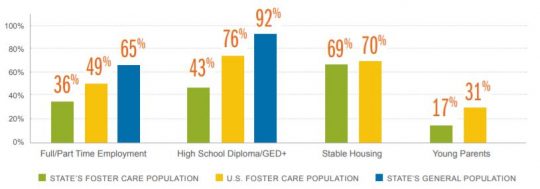
In response to this, Ohio has taken significant steps to reverse this course through the BRIDGES program. This program provides transitional housing, jobs training, higher education support, and other services to help youth as they navigate the complexities of adulthood and being on their own. However, we know that much more is needed. In Gov. DeWine’s first biennial budget (FY 2020-2021) , the enacted budget included doubled funding for child welfare services in Ohio, which represents a significant investment given the growing demand in services.
Ohio’s First Youth Ombudsman, A Hard-Won Victory for Youth Advocates
The Youth Ombudsman is beacon of hope for youth who experienced maltreatment and found that the current child welfare system failed to protect them. For these young Ohioans, who have fiercely advocated for this Youth Ombudsman office over the last year, it is an opportunity to ensure that the same traumas they experienced are not allowed to persist and harm future generations of Ohio children.
The Foster Youth Bill of Rights sends a clear message to young people that they matter
Children’s Defense Fund-Ohio recently partnered with the Child Welfare Training Program to elevate the voices of those with lived experience in foster care youth to to advance an understanding of why it is important to protect the rights of youth in care. Their insights about the experience of being in care are focused on helping caregivers understand what it is like to be in foster care.
Protecting the safety and rights of youth in foster care is essential to their wellbeing and development, allowing them to reach their full potential. Unfortunately, Ohio ranks near the bottom of the country for young adults who were in foster care who are reaching their potential. A staggering 40% lack a high school diploma, more than half were unemployed at age 21 and more than 1 in 3 experienced homelessness. CDF-Ohio is committed to improving these outcomes by protecting youth rights and empowering youth the reach their full potential.
 Measuring Transformation: Elevating Youth Voice in the Child Welfare System
Measuring Transformation: Elevating Youth Voice in the Child Welfare System
April 14, 2022
Earlier today, Kim Eckhart was joined by foster youth advocates Deanna Jones and Laila-Rose Hudson to share CDF-Ohio’s latest report, Measuring Transformation: Elevating Youth Voice in the Child Welfare System.
This new report shows that Ohio ranks in the bottom 10% of the nation on four measures of wellbeing for youth aged 21 who were in foster care in their teens. It analyzes data from 2018 that shows Ohio’s youth are less likely to graduate high school or get their GED, obtain employment, or be enrolled in school and more likely to be justice system-involved compared to their peers in other states. It also highlights perspectives from youth, shares data showing where we are as a state, and gives recommendations for how we navigate toward a better future for children. It also features data profiles on child welfare indicators for all 88 Ohio counties.
Review the Webinar Slide Deck for Measuring Transformation where the report’s author and advocates with lived experience in foster care share how we can make Ohio a place where all of our children can thrive and have a voice in the policies that impact their livelihoods.
Featured Speakers:
• Kim Eckhart, KIDS COUNT Project Manager, Children’s Defense Fund-Ohio
• Deanna Jones, MPA, BSSW, LSW, Children’s Defense Fund-Ohio Consultant
• Laila-Rose Hudson, JD pending May 2022, Child Welfare Advocate
 Youth Deserve to be Heard: CDF-Ohio and Partners Advocate for Independent Foster Youth Ombuds Office in HB 4
Youth Deserve to be Heard: CDF-Ohio and Partners Advocate for Independent Foster Youth Ombuds Office in HB 4
October 20, 2021
In Ohio, abuse and neglect cases continue to increase each year, with over 200,000 referrals made in 2019 alone. Pandemic-related restrictions have left many children at higher risk for child abuse and neglect due to less frequent contact with mandated reporters. As a result, many cases within the last year are going unreported, leading emergency rooms in Ohio to see an influx in the number of child abuse cases. The need for a statewide Youth Ombudsman Office pre-dates the current global pandemic—but is now more critical than ever. Read the Coalition’s full letter and recommendations to legislative leaders.
Youth Ombudsman Issue Brief
February 18, 2022
By Kim Eckhart, KIDS COUNT Project Manager
A Youth Ombudsman office will give youth a voice by investigating their reports of unsafe
conditions in the foster care system. Youth advocates, as part of the Youth Ombudsman Coalition, succeeded in efforts to establish a Youth Ombudsman as part of House Bill 4. Once effective, the governor will appoint a Youth Ombudsman dedicated to serving youth. The OHIO Youth Advisory Board will have a role both in the appointment process and in evaluating the annual report to ensure that youth needs are being met. Learn more and download the Issue Brief.
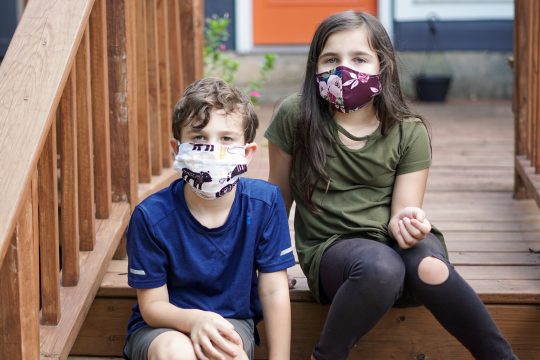 Action Alert! Ohio’s Biennial Budget is Opportunity to Make Positive Change for Foster Youth
Action Alert! Ohio’s Biennial Budget is Opportunity to Make Positive Change for Foster Youth
HB 110 is an opportunity for Ohio to follow the example of 13 other states that have independent Ombudsman’s Offices established by the legislature, and to define its purpose and design.
Creating an Ombuds office through the state’s biennial budget (HB 110) will protect children and teens by empowering them to self-report abuse and following up with an independent investigation. The biennial budget is currently in the Senate and hearings are scheduled over the next several weeks and you can view them live (or archived) on the Ohio Channel.
Blog Posts
 Make your Mark: Learning to Advocate for Meaningful Policy Change
Make your Mark: Learning to Advocate for Meaningful Policy Change
May 28, 2021
CDF-Ohio partnered with the Junior League of Columbus on Wednesday evening to host: Make your Mark: Learning to Advocate for Meaningful Policy Change. Jaye Turner, member of ACTION Ohio and founder of El’lesun, a non-profit that advocates and supports our foster care community, co-presented with Kim Eckhart, KIDS COUNT Project Manager. They addressed the intersection of ways to make an impact, from direct service to systems-level change with the specific example of the Youth Ombudsman Advocacy Campaign happening now.
View Information Shared Here. Junior League Information Session
The past two weeks have been very busy as our team works with the Senate to build awareness on the importance of a You Ombuds Office and a Youth Bill of Right. We are proud to work side-by-side with current and former foster youth as they share their experiences, expertise, and recommendations for how to make the child welfare system more youth focused and honor the voices of youth. Below are video clips of testimony provided by each of our partners over the last two weeks and the types of questions they received from our policymakers.
May 18th Day at the Statehouse
Senator Craig’s Question: Where should the office be housed?
Senator Dolan’s Question: Is there a state that has a dedicated youth ombudsman?
May 13th Day at the Statehouse
Senator Sykes’ Question: Do you have recommendation on where this office would be housed?
Senator Craig’s remarks on the process for determining the structure.
May 5th Day at the Statehouse
Jermaine’s testimony in the Senate Health Committee
May 4th Day at the Statehouse
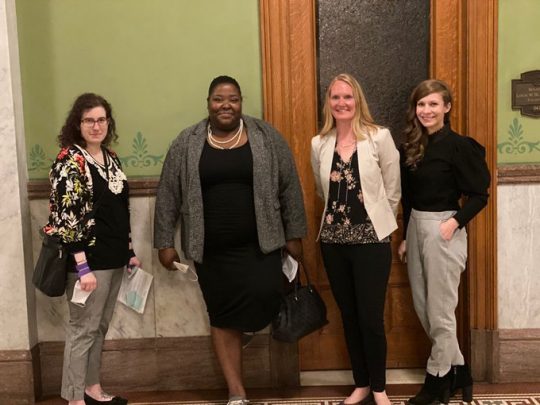 Children’s Defense Fund-Ohio Partners with Foster Youth Action to Advocate for Foster Youth Ombuds Office
Children’s Defense Fund-Ohio Partners with Foster Youth Action to Advocate for Foster Youth Ombuds Office
Children’s Defense Fund-Ohio is proud to partner with former youth and foster youth alumni from ACTION Ohio to give voice to changes to better needed support youth in the child welfare system. Too often children who are involved in the child welfare system in Ohio lack power and voice to advocate for their wellness and safety. Further, they lack the ability to point to a list of “rights” they have as child who is in the custody of the child welfare system. The creation of a Youth Bill of Rights and a Foster Youth Ombuds Office would provide a structure and process for children to self-advocate and provide additional outlets for them to voice their needs and concerns. Our colleague, Kim Eckhart testified in partnership with Nikki Chinn, Deanna Jones, and Juliana Barton representing ACTION Ohio. Below is Kim’s testimony.
Download Kim’s Child Welfare Testimony
Watch Testimony on HB 4, Creating a Foster Youth Ombuds Office
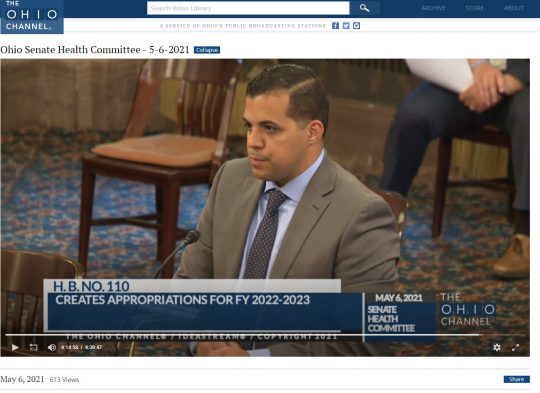 Video of Jermaine’s testimony in the Senate Health Committee: https://www.ohiochannel.org/video/ohio-senate-health-committee-5-6-2021?start=15291&end=15782
Video of Jermaine’s testimony in the Senate Health Committee: https://www.ohiochannel.org/video/ohio-senate-health-committee-5-6-2021?start=15291&end=15782
Video of Jermaine’s testimony HB 4: https://www.ohiochannel.org/video/ohio-house-families-aging-and-human-services-committee-5-6-2021?start=134&end=1391
Video of Kim testimony HB 4: https://www.ohiochannel.org/video/ohio-house-families-aging-and-human-services-committee-5-6-2021?start=1417&end=2414

Ohio’s FY22-23 budget bill could pave the way to creating a Youth Ombuds Office that would protect and give voice to youth in the foster care system
April 30, 2021
By Kim Eckhart, KIDS COUNT Project Manager
After years of advocacy by current and former foster youth, Ohio is on its way to developing an independent Youth Ombuds Office to protect the rights of children and youth in care by investigating and resolving reports brought by youth themselves. The office would act as a safeguard to ensure that youth have someone to call who will listen and advocate for them.
“When I was a child, I used to wish that someone would stop by our house and that they would find us. It never happened. My summers were filled with abuse and fear… By providing a venue where the voices of youth can be heard without fear of retribution, this office will ensure the safety of Ohio’s youth,” said Jonathan Thomas, the NW Ambassador of the Overcoming Hurdles in Ohio Youth Advisory Board (OHIO YAB).
May is National Foster Care Awareness Month, and Thomas and other members of Ohio YAB, in partnership with CDF-Ohio and ACTION Ohio, are launching an advocacy campaign [AP1] to bring awareness to opportunities for our state to better support former and current foster youth as the state budget is being deliberated. The advocates are calling for provisions that clearly state that the office should be dedicated to youth, independent from children’s services and designed by current and former foster youth. The Ohio YAB is a statewide organization of young people (aged 14-24) who have experienced foster care. ACTION Ohio (Alumni of Care Together Improving Outcomes Now Ohio (ACTION Ohio) is dedicated to improving outcomes for current and former foster care youth.
The campaign kicks off with the release of the Youth Ombuds Office Legislative Issue Brief and advocacy toolkit, followed by more than a dozen legislative visits with youth who have lived experience in foster care to explain the importance of this office. The campaign will ramp up in May during Foster Care Awareness Month will include testimony at Senate hearings on the FY22-23 budget bill. On May 17th, youth will present at the next meeting for the Ohio Legislative Children’s Caucus, a bipartisan, bicameral caucus devoted to championing children’s issues.
“The voices and involvement of those with lived experience is key to making this office a success. My recommendation for an ombudsman goes beyond just having an independent agency/office doing the necessary investigations and advocating for youth. I believe that having someone working in this office, with the experience of going through foster care, is essential. While anyone can work to understand what it is like to go through the system, there is no better expert than those that have directly experienced it,” said Jeremy Collier, former foster youth and current advocate.
Governor DeWine has stated that $1 million in the FY22-23 biennial budget will be set aside in the Department of Job and Family Services to establish an Ombuds Office. This follows the Children’s Services Transformation Advisory Council recommendation to create an Ombuds Office for caregivers and youth in its 2020 report. However, the bill does not include a specific Appropriation Line Item (ALI) or earmark to designate this funding.
The advocacy campaign is focused on the short-term goals of including funding and adding provisions in HB110 that clarify three specific characteristics of the office
- Clearly state that the office will be dedicated to youth.
- Clearly state that the office will be independent from the Department of Job and Family Services.
- Clearly state that current and former foster youth will have a role in the design and implementation of the office.
 Addressing Racial Bias & Inequity in Child Welfare
Addressing Racial Bias & Inequity in Child Welfare
February 25, 2021
By Kim Eckhart, KIDS COUNT Project Manager
As a community, we have a responsibility to ensure that the systems we have created to protect children from abuse and neglect are free from racial bias. As we confront the awful reality that racial bias permeates all of our systems, including the child welfare system, we owe it to our children to be courageous, humble and honest about the cumulative impact of our individual actions.
The impact is stark and far-reaching. According to a report by Ohio’s Children Services Transformation (CST) Advisory Council: Black and multi-racial children are about two to three times as likely to be referred to children services, to have abuse and neglect reports screened in, and to be placed out of home compared to white children.
We can and must do better for Black and Brown children in Ohio’s child welfare system.
Read more here.
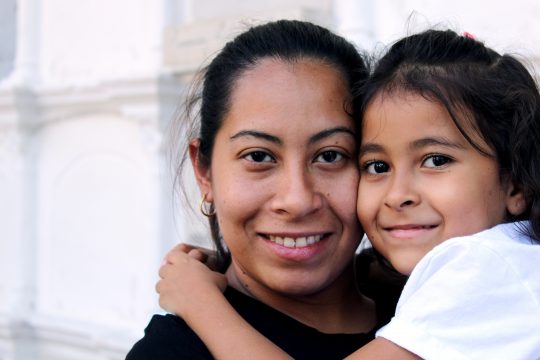 The Child Welfare System through the Lens of a Court Appointed Special Advocate (CASA)
The Child Welfare System through the Lens of a Court Appointed Special Advocate (CASA)
November 16, 2020
By Kendal Glandorff, Intern
Becoming a Court Appointed Special Advocate (CASA) for Franklin County has been the single, most life-changing, best decision I have ever made. As a current social work student who is passionate about reforming the child welfare system to ensure it adequately serves every child, I have made it my mission to learn all the ins and outs that make up this system. Over the past six months as a volunteer, I have seen first-hand the need for reforms in key areas.
As a community, we must envision a system that offers support to families and children to help them thrive. As children come into contact with the child welfare system, we have an opportunity to provide meaningful interventions that prevent painful separations. However, in 2018, Ohio had a 7.8 percent recurrence rate causing the state to be among the ten states with the highest recurrence rates (Children’s Bureau, 2018). Download full article here.
ZERO TO THREE Announces State and Local Program Development Grants to Expand Infant-Toddler Court Teams Across the U.S.
January 28, 2021
Children’s Defense Fund-Ohio and Groundwork Ohio are excited to partner on the Zero To Three Safe Baby Court Team project. For updates on this project, please visit: Groundwork | Safe Baby Court Team | Child Welfare (groundworkohio.org)
October 1, 2020
Grantees across country to receive support in improving outcomes for young children in foster care.
Washington, D.C. (Oct. 1, 2020) — Today, ZERO TO THREE’s National Resource Center for the Infant-Toddler Court Program (NRC) announced that 16 organizations from across the country will receive grants between $75,000 and $425,000 to implement new infant-toddler court teams or increase their alignment with the Safe Babies Court Team™ approach. Read more about the Infant-Toddler Court Team program.
 Transforming the child welfare system through Family First Prevention Services and Safe Babies Court TeamsTM
Transforming the child welfare system through Family First Prevention Services and Safe Babies Court TeamsTM
September 29, 2020
By Kim Eckhart, KIDS COUNT Project Manager
When babies and toddlers come into contact with the child welfare system, they deserve the best possible outcome: a safe, nurturing and permanent family. The science of early childhood development has shown that children who live in safe and supportive homes have the best chance for healthy development throughout their lives. As we work to transform the child welfare system to improve outcomes for children, two complementary initiatives offer a path forward: Family First Prevention Services (Family First) and Safe Babies Court Teams (Safe Babies). Read more here.
New legislation is a first step in meeting the growing demand for more safe and supportive homes for children in foster care.
September 4, 2020
By Kim Eckhart, KIDS COUNT Project Manager
 All children deserve a safe and supportive home. That’s why the Children’s Defense Fund-Ohio is encouraged by new legislation aimed to address the shortage of foster homes available to children throughout Ohio. On September 2nd, Ohio passed House Bill (HB) 8 to provide more flexibility in training requirements, including allowing some training to be conducted online, to become a licensed foster caregiver.
All children deserve a safe and supportive home. That’s why the Children’s Defense Fund-Ohio is encouraged by new legislation aimed to address the shortage of foster homes available to children throughout Ohio. On September 2nd, Ohio passed House Bill (HB) 8 to provide more flexibility in training requirements, including allowing some training to be conducted online, to become a licensed foster caregiver.
Meeting the Growing Demand. Recruiting and efficiently licensing new caregivers will help meet the critical need in Ohio for safe and supportive homes for children and teenagers who are not able to live with their biological families. In 2018, over 26,000 children were placed out of home and 12% of those were in group or residential care. The need for caregivers trained to meet the emotional and behavioral needs of children who have experienced trauma has only increased. This critical need for more trained caregivers was clearly demonstrated prior to 2020, but markedly so this year during the pandemic, with alarming reports of children living in children’s services offices. Read more here.
 It’s time to reimagine how we create safe and supportive environments for children removed from their families
It’s time to reimagine how we create safe and supportive environments for children removed from their families
July 16, 2020
By Kim Eckhart, KIDS COUNT Project Manager
A lack of placement options has been an ongoing concern across the state. Now, with COVID-19 causing many foster parents to close their doors, creating new solutions is more important than ever.
Last week, Sonia Emerson led a demonstration outside of the Cuyahoga County children’s service building with other youth advocates with lived experience in the foster care system. In response to a report that a child spent weeks living there, Sonia said. Read more here.
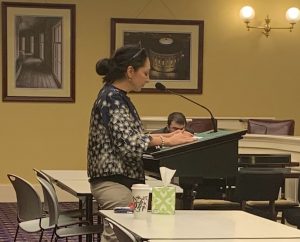 Immediate Improvements Are Needed in Ohio’s Child Welfare System
Immediate Improvements Are Needed in Ohio’s Child Welfare System
July 1, 2020
By Tracy Nájera, Executive Director
In this past week, CDF-Ohio learned of a situation in Cuyahoga County where a child being “housed” at the Cuyahoga County Children’s Services Office for an extended period of time as the county searched for appropriate placement. Let’s be clear – if the child’s birth family was housing them in an office, it would not be seen as acceptable and would likely be seen as grounds for removal. Children need consistency and stability. They need to be able to build connections. They need to know that they are being cared for and taken care of. The extent of this practice and how often its used is unknown. Further, COVID-19 and the economic toll that its taking on families may result in surges in child welfare calls and put additional strains on the system. More is needed to protect vulnerable children with complex needs. CDF-Ohio issued a statement about this situation and we are calling for immediate changes and put forward policy recommendations to protect children from this in the future. We look forward to working with state and local partners in the coming weeks and months. Read the full statement here.
Resources & Publications
The COVID-19 pandemic has put additional strains and challenges on an already struggling child welfare system. The state of Ohio and the federal government has an obligation to support our most vulnerable children and continue funding for child welfare services, support of foster parents and kinship care providers, and the children in their care. Further, during this time, we must also ensure that youth who are aging out of foster care during this time have the option of extending their time in foster care and continuing support as they transition into adulthood.
2019 PCSAO Factbook, Public Children’s Services Association of Ohio
2018 Ohio Profile, Transition-Age Youth in Foster Care – Annie E. Casey Foundation
Letters to the Ohio Congressional Delegation – May 7, 2020
- Senate Letter: Emergency Funding for Child Welfare in the next COVID-19 Relief package
- House Letter: Emergency Funding for Child Welfare in the next COVID-19 Relief package
Statement Child Welfare – June 29, 2020

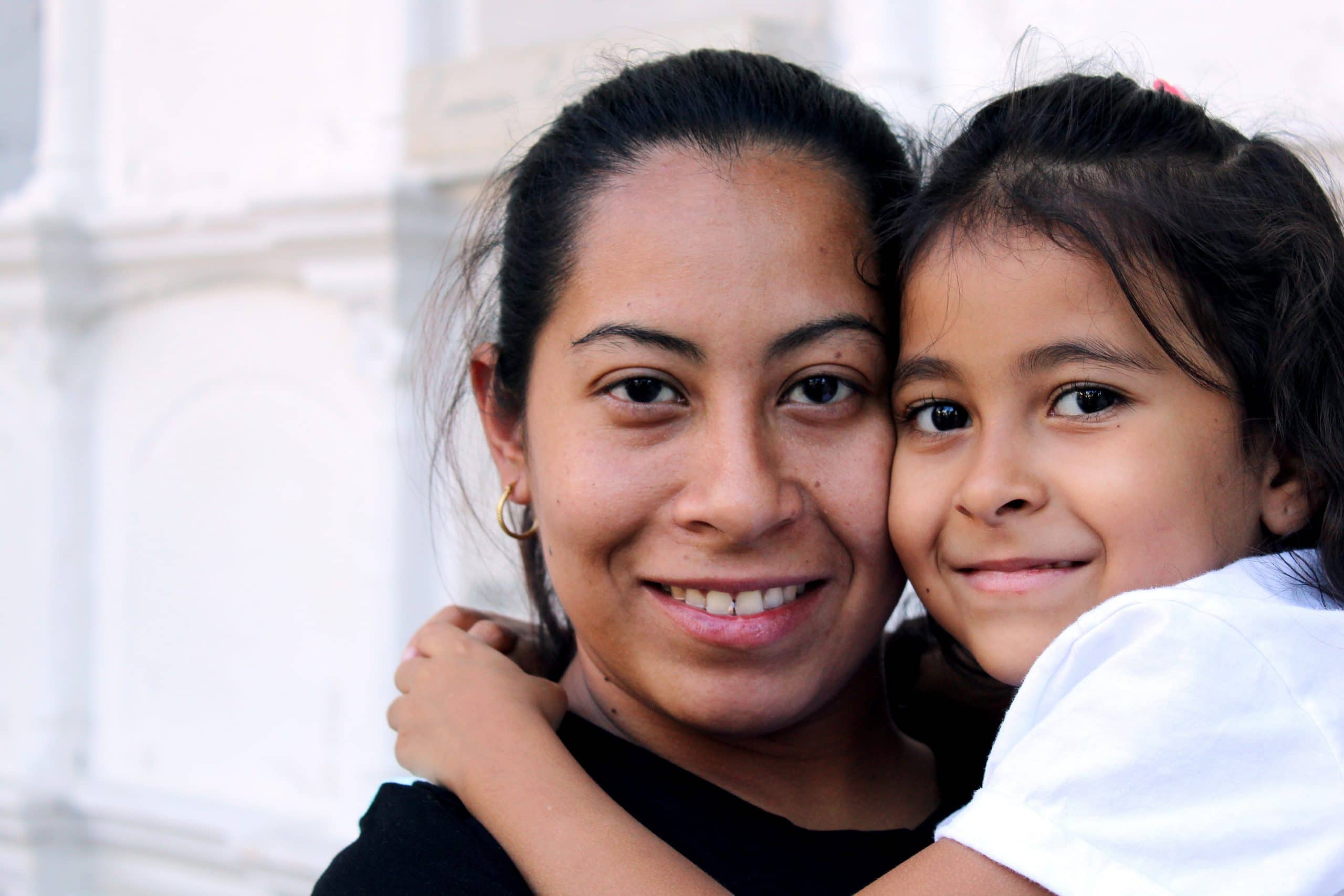
 Child Welfare
Child Welfare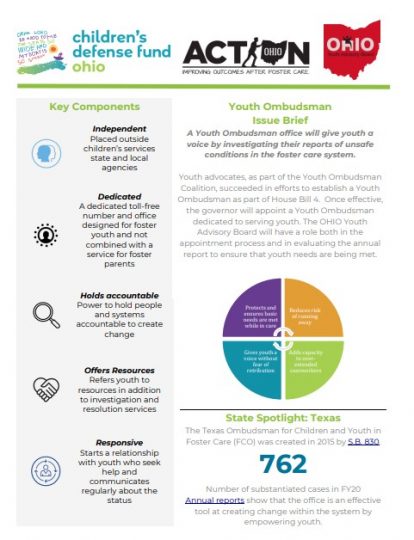

 It’s time to reimagine how we create safe and supportive environments for children removed from their families
It’s time to reimagine how we create safe and supportive environments for children removed from their families